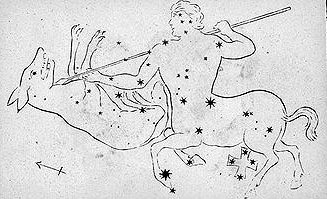5. In addition to Nga Vaka (α and β) there are 5 further stars in Centaurus which have been assigned Greek letters:
Allen: "In China κ was Ke Kwan, a Cavalry Officer ..." Ma Wei (δ in September 21) was 'the Horses' Tail' and in the European version of Centaurus the star κ is the outstretched forearm. The 'Horse' seems in China to be rising a little later. The position at the end of Centaurus is presumably significant, because the Greek letter κ is derived from the Phoenician kaph - cfr the similarly positioned κ Aurigae (at Coma Berenices II): ... Kaph is thought to have been derived from a pictogram of a hand (in both modern Arabic and modern Hebrew, kaph means palm/grip) ... The 'grasping hand' is evidently like some venomous snakes waiting for the last person in the line, an idea which appears to be in harmony with the type of glyph (rau hei) at κ Centauri. It has been proposed, though I cannot remember my source, that the word elementa comes from an old alphabet which began with the letters L, M, and N. If so, then K could have been the last letter. Allen does not mention Menkent, but in Wikipedia we can read: "Theta Centauri (θ Cen, θ Centauri) is a star in the southern constellation of Centaurus, the centaur. It is has the traditional Arabic name Menkent (possibly abbreviation of al mankib al-qanturis, meaning 'shoulder of the Centaur')."
| ||||||||||||||||||||||||||||||||||||||||||||||||||||||||||||||||||||||||||||||||||||||||||||||||||||||||||||||||||||||||||||||||||||||||||||||||||||||||||||||||||||||||||||||||||||||||||||||||||||||||||||||||||||||||||||||||||||||||||||||||||||||||||||||||||||||||||









